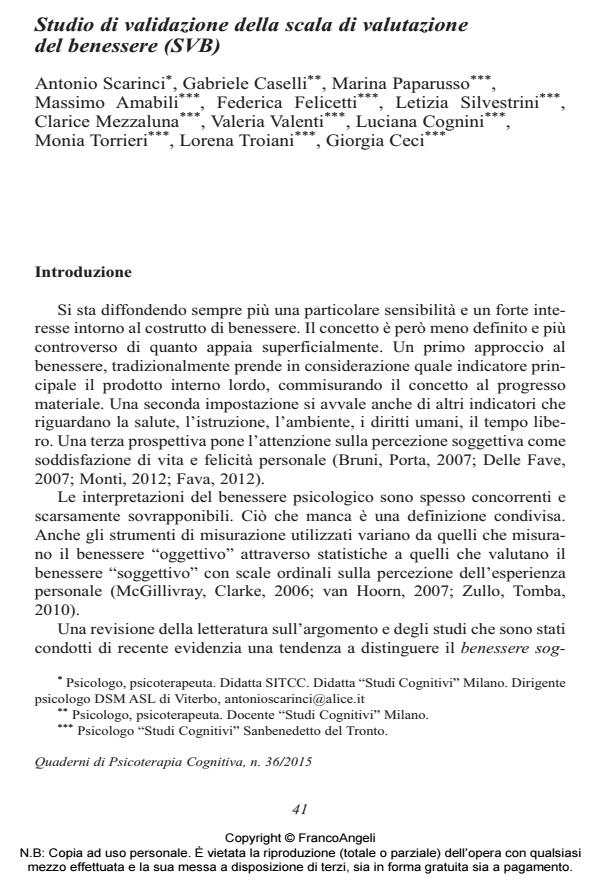Validation study of Well-being Assessment Scale (WAS)
Journal title QUADERNI DI PSICOTERAPIA COGNITIVA
Author/s Antonio Scarinci, Gabriele Caselli, Marina Paparusso, Masimo Amabili, Federica Felicetti, Letizia Silvestrini, Clarice Mezzaluna, Valeria Valenti, Luciana Cognini, Monia Torrieri, Lorena Troiani, Giorgia Ceci
Publishing Year 2015 Issue 2015/36
Language Italian Pages 18 P. 41-58 File size 146 KB
DOI 10.3280/QPC2015-036004
DOI is like a bar code for intellectual property: to have more infomation
click here
Below, you can see the article first page
If you want to buy this article in PDF format, you can do it, following the instructions to buy download credits

FrancoAngeli is member of Publishers International Linking Association, Inc (PILA), a not-for-profit association which run the CrossRef service enabling links to and from online scholarly content.
The attention around the well-being has grown considerably in recent years. Nevertheless, the concept has not yet been defined in unambiguous terms. In this paper, we propose a theoretical model developed by taking into consideration the factors that influence the process of the preeminent well-being. Meaning of life, full and harmonious relations, awareness, acceptance and transcendence emerge from psychological research and neuroscience as part of the promotion of well-being. Based on this approach has been developed an assessment tool: the Well-being Assessment Scale (WAS). The WAS is composed of 22 items that form 4 subscales, one for each variable (the meaning of life and consciousness, relatedness, acceptance, transcendence). Aversion of 40 items selected from previously validated instruments has been subjected to 122 subjects recruited from the community. An initial exploratory factor analysis has revealed a four-factor structure. From the correlation matrix for each factor were selected the items that define the final structure of the WAS. This version was administered to 176 subjects. The structure of the WAS was analyzed through confirmatory factor analysis. The convergent and discriminant validity was assessed by comparison with other instruments that measure psychological well-being and general psychopathological symptoms. The test results showed good psychometric properties of the instrument, but needs further study.
Keywords: Well-being, meaning of life, relatedness, acceptance, awareness, transcendence.
Antonio Scarinci, Gabriele Caselli, Marina Paparusso, Masimo Amabili, Federica Felicetti, Letizia Silvestrini, Clarice Mezzaluna, Valeria Valenti, Luciana Cognini, Monia Torrieri, Lorena Troiani, Giorgia Ceci, Studio di validazione della scala di valutazione del benessere (SVB) in "QUADERNI DI PSICOTERAPIA COGNITIVA" 36/2015, pp 41-58, DOI: 10.3280/QPC2015-036004